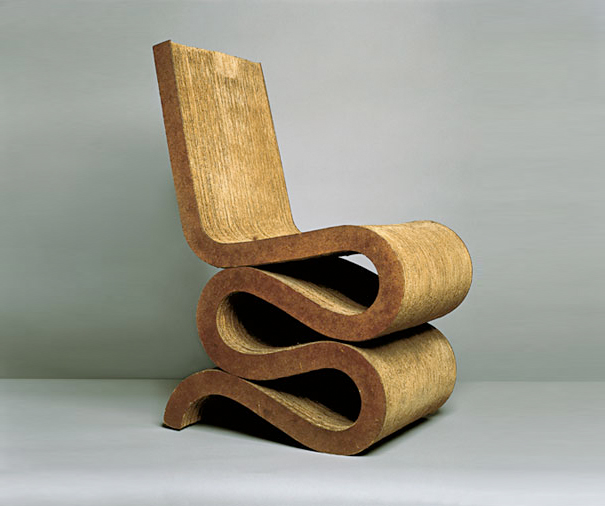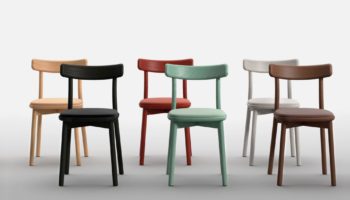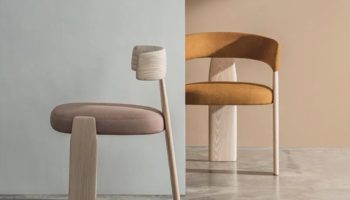Gehry’s Wiggle Chair
In this age of “Oh my God we’re running out of oil and filling up the earth with junk!”, several culprits of the “easily produced and disposed of” variety emerge as foremost offenders. One task of the green conscious designer is to find a use for these cheap materials.
Wiggle Chair. Designed by Frank Gehry. Manufactured by Vitra.
Back in March, we featured an elegant lightpiece by Marcel Sigel and Alana Di Giacomo of Zuii. Sigel and Di Giacomo created a chandelier of alluring and exotic aspect out of none other than-that figurative scapegoat of all that’s wrong with Western civilization-the ubiquitous grocery store plastic bag. Kudos to them, but one giant figure in architecture/design may have beat them to the altar of reusability: the year was 1972, gas cost 36 cents/galloon, the chocolate smooth grooves of Al Green’s “Let’s Stay Together” topped the music charts, and a prominent architect turned his hand towards creating furniture from corrugated cardboard.


Frank Gehry’s “Easy Edges” series debuted in 1969. The culmination of a “fundamental concern with manipulating basic materials in unconventional ways to produce objects that are functional yet also visually striking,” the collection featured super-strong laminates made of layer upon layer (upon layer-some 60 sheets for his classic “Wiggle Chair”) of this omnipresent packing material. Taking advantage of cardboard’s inherent elasticity, Gehry was able to craft chairs and tables that featured impossible curves. To wit, the Wiggle Chair has all the taut dynamism and coiled power of a seething serpent. In a way that has yet to be matched, Gehry used the material to create facsimiles of animal movement, and no designer before or since has matched Gehry’s penchant for an uncanny naturalism. Looking at the Wiggle Chair, you half expect it to uncoil and slink away, inscribing serpentine Ss on the linoleum as it slithers outside and coils up the nearest tree. But Gehry’s achievement goes beyond envisioning new forms-the original Easy Edges series was executed extremely quickly and at relatively low cost. According to press material for The Guggenheim, Gehry’s furnishings are a “quick fix of his architectural practice: their realization is relatively immediate and low cost, and they provide a satisfying smaller forum in which various design concerns may be explored.”
The “low cost” part must have been a Godsend at the time (very like the cheap gas), but, alas, it too has become a mere artifact: Vitra’s re-issue of Gehry’s Cardboard and Hardboard Wiggle Chair is yours for the low low price of $1,250.00. This-in concert with the piece’s funky, retro, Kubrickian anti-future kind of aesthetic-makes me think there will come a time (can anyone say “Apocalypse”?) when we place tremendous value on the things we throw away. Gehry’s wonderful Wiggle Chair is certainly one great example of how to make use of our pervasive detritus.




Leave a Reply